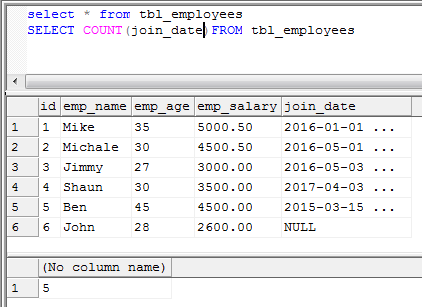


In the scriptīelow, a WHILE loop will continue executing the entire statement, that is used to delete all rows with NULL GUIDs inīatches, and stop executing when the number of rows that match that condition equal to 0, as shown below: Matches the specified condition reach a specific value, rescuing it from falling in an infinite loop. The SQL Server system variable can be used also to control the loop and stop it when the number of rows Table and print a relative comment, as shown below: Rows from the source table, then an IF condition statement is used to check the number of rows retrieved from that For example, a SELECT statement is used to retrieve a number of The number of rows returned from the last statement. The SQL Server can be used in the IF statement condition to control the flow of the statement, based on Query, and will return 1, which is the number of rows affected by the calling statement, as shown below: What will happen if I call it in a separate execution?Īn important thing to consider here is that, if you try to run a specific query then call the SQL Server a different execution, the value returned will not reflect the correct number of rows affected by the previous Then store that rows number in the system variable, as shown below: So, the last INSERT statement will insert one row This is because each INSERT statement in this query affects only one row. Then check the value stored in the system variable, you will find that the value equal to 1. For example, if we try to execute an INSERT statement 20 times, using the GO 20 statement, In the batch executions, the SQL Server system variable will store the number of rows affected by the last batch execution. Number of rows deleted by the executed statement, is retrieved in the same execution of the DELETE statement, as In the script below, the value of the system variable, which reflects the You can also use the SQL Server system variable to return the number of rows that are affected by theĮxecuted DELETE statement.
MYSQL COUNT ROWS IN ALL TABLES UPDATE
Rows updated by that statement, is retrieved in the same execution of the UPDATE statement, as shown below: In the following script, the value of the system variable, which reflects the number of The SQL Server system variable can be used also to check the number of rows that are affected by an

The SQL Server will returnĢ96, which is the number of rows affected by the second SELECT statement, as shown below: Statement returned 290 rows and the second SELECT statement returned 296 rows. If you run two SELECT statements in the same execution, followed by calling you will see that it will return the number of rows returned from the second SELECT statement.

The previous SELECT statement read the whole source table’s rows, which is 290 only, as shown below: Value stored in the SQL Server system variable, you will see that the returned value is 290, not 1000, as If we try to modify the previous query to retrieve the top 1000 records from the target table, then try to check the In theīelow T-SQL query, a SELECT query is used to retrieve the top 100 records from the Employee table, and in the sameĮxecution, we retrieve the number of rows that are read from the source table, which is 100 rows as in the The simple use for the SQL Server system variable is calling it directly after a SELECT statement. Let us go through several examples that show the different ROWCOUNT usage scenarios. It is also used for error handling to check the number of affected rows within the statement. The execution, taking into consideration that both the rows affecting statement and the system variableĬalling query are in the same is used frequently in the loops to prevent the infinite loops and stop the current process when all the target rows are processed. The rows affecting statement can be any INSERT, UPDATE, DELETE or SELECT statement that is executed directly before SQL Server is a system variable that is used to return the number of rows that are affected by the last executed statement in the batch. In this article, we will discuss the SQL Server and ROWCOUNT system objects by going through practicalĮxamples that cover most of these system objects usage.


 0 kommentar(er)
0 kommentar(er)
